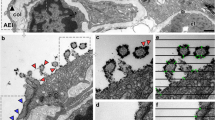Abstract
The pathogenesis of pneumonitis associated with meconium aspiration is poorly understood. To explore the possibility of pulmonary cytotoxicity in association with bile salt exposure and calcium accumulation, we compared cell viability, radiolabeled calcium accumulation, and intracellular [calcium] in the presence and absence of bile salts, chenodeoxycholate, and 3β-OH-5-cholenoate. We assessed viability of type II pneumocytes in culture by cell permeability to trypan blue dye, incorporation of leucine into cellular proteins, and cellular morphology. Intracellular calcium concentrations were monitored with fluorescent dye methodology. At micromolar concentrations, the above bile salts increased cell permeability by as much as 9-fold and decreased leucine incorporation by as much as 5-fold. Radiolabeled calcium accumulation increased by as much as 2.5-fold and intracellular [calcium] transiently increased by as much as 6-fold. Studies using bile salts extracted from meconium yielded similar results. Correlation of calcium accumulation to viability studies yielded a direct relationship with cell permeability and an inverse relationship with leucine incorporation. We speculate that bile salt-induced accumulation of intracellular calcium in lung cells may contribute to the pathogenesis of meconium aspiration pneumonitis.
Similar content being viewed by others
References
Aoyagi T, Lowenstein LM (1968) The effect of bile acids and ischemia on renal function. J Lab Clin Med 71:686–692
Back P, Walter K (1980) Developmental pattern of bile acid metabolism as revealed by bile acid analysis of meconium. Gastroenterology 78:671–676
Bogin E, Better O, Harari I (1983) The effect ofjaundiced sera and bile salts on cultured beating rat heart cells. Experientia 39:1307–1310
Carey MC, Small DM (1972) Micelle formation by bile salts. Arch Intern Med 130:506–527
Child P, Rafter J (1986) Calcium enhances the hemolytic action of bile salts. Biochim Biophys Acta 855:357–364
Clark DA, Nieman GF, Thompson JE, Paskanik AM, Rokhar JE, Bredenberg CE (1987) surfactant displacement by meconium free fatty acids: an alternative explanation for atelectasis in meconium aspiration syndrome. J Pediatr 110:765–770
Clark MR, Mohandas N, Feo C (1981) Separate mechanisms of deformability loss in ATP-depleted and Ca-loaded erythrocytes. J Clin Invest 67:531–539
Combettes L, Dumon M, Berthon B, Erlinger S, Claret M (1988) Release of calcium from the endoplasmic reticulum by bile acids in rat liver cells. J Biol Chem 263:2299–2303
Cruickshank AH (1949) The effects of the introduction of amniotic fluid into rabbits’ lungs. J Pathol Bacteriol 61:527–531
Farber JL (1982) Calcium and mechanisms of liver necrosis. In: Popper H, Schaffner F (eds) Progress in liver diseases, vol VII. Grune and Stratton, New York, pp 327–360
Fisehr AB, Furia L, Berman H (1980) Metabolism of rat granular pneumocytes isolated in primary culture. J Appl Physiol 49:743–750
Florman AL, Teubner D (1969) Enhancement of bacterial growth in amniotic fluid by meconium. J Pediatr 74:111–114
Grynkiewicz G, Poenie M, Tsien RY (1985) A new generation of Ca2+ indicators with greatly improved fluorescence properties. J Biol Chem 260:3440–3450
Henderson RD, Fung K, Cullen JB, Milne ENC, Marryatt G (1975) Bile aspiration: an experimental study in rabbits. Can J Surg 18:64–69
Herndon JH (1972) Pathophysiology of pruritus associated with elevated bile acid levels in serum. Arch Intern Med 130:632–637
Holmes RP, Yoss NL (1984) 25-hydroxysterols increase the permeability of liposomes to Ca2+ and other cations. Biochim Biophys Acta 770:15–21
Kikkawa Y, Yoneda Y (1974) The type II epithelial cell of the lung. I. Method of isolation. Lab Invest 30:76–84
Lauterburg BH (1987) Early disturbance of calcium translocation across the plasma membrane in toxic liver injury. Hepatology 7:1179–1183
Morgan BP, Luzio JP, Campbell AK (1986) Intracellular Ca2+ and cell injury: a paradoxical role of Ca2+ in complement membrane attack. Cell Calcium 7:399–411
Murphy JD, Vawter GF, Reid LM (1984) Pulmonary vascular disease in fetal meconium aspiration. J Pediatr 104:758–762
Nicotera P, Hartzell P, Baldi C, Svensson SA, Bellomo G, Orrenius S (1986) Cystamine induces toxicity in hepatocytes through the elevation of cytosolic Ca2+ and the stimulation of a nonlysosomal proteolytic system. J Biol Chem 261:14628–14635
Oelberg DG, Wang LB, Sackman JW, Adcock EW, Lester R (1988) Bile salt-induced calcium fluxes in artificial phospholipid vesicles. Biochim Biophys Acta 937:289–299
Oelberg DG, Chari MV, Little JM, Adcock EW, Lester R (1984) Lithocholate glucuronide is a cholestatic agent. J Clin Invest 73:1507–1514
Oelberg DG, Dubinsky WP, Sackman JW, Wang LB, Adcock EW, Lester R (1987) Bile salts induce calcium uptake in vitro by human erythrocytes. Hepatology 7:245–252
Palek J, Liu SC, Liu PA (1978) Crosslinking of the nearest membrane protein neighbors in ATP-depleted, calcium enriched and irreversibly sickled red cells. In: Kruckeberg WC, Eaton JW, Brewer GJ (eds) Erythrocyte membranes: recent clinical and experimental advances. Alan R Liss, New York, pp 75–78
Rubovits WH, Taft E, Neuwelt F (1938) The pathologic properties of meconium. Am J Obstet Gynecol 48:501–505
Schwarz HP, Bergmann KV, Paumgartner G (1974) A simple method for the estimation of bile acids in serum. Clin Chim Acta 50:197–206
Setchell KDR, Worthington J (1982) A rapid method for the quantitative extraction of bile acids and their conjugates from serum using commercially available reverse-phase octadecylsilane bonded silica cartridges. Clin Chim Acta 125:135–144
Shields M, LaCelle P, Waugh RE, Scholz M, Peters S, Passow H (1987) Effects of intracellular Ca++ and proteolytic digestion of the membrane skeleton on the mechanical properties of the red blood cell membrane. Biochim Biophys Acta 905:181–194
Trias X, Strebel HM, Paumgartner (1977) Effects of bile and bile acids on cultured human fibroblasts. Eur J Clin Invest 7:189–194
Tyler DC, Murphy J, Cheney FW (1978) Mechanical and chemical damage to lung tissue caused by meconium aspiration. Pediatrics 62:454–459
Weissman G, Keiser H (1965) Hemolysis and augmentation of hemolysis by neutral steroids and bile acids. Biochem Pharmacol 14:537–546
Weissmann G (1985) Liposomes as vectors for calcium ionophores. Ann NY Acad Sci 446:385–389
Zimniak P, Oelberg DG, Lester R (1987) Bile salts as calcium ionophores in Ca-ATPase containing liposomes. Hepatology 7:245–252 (abstr)
Author information
Authors and Affiliations
Rights and permissions
About this article
Cite this article
Oelberg, D.G., Downey, S.A. & Flynn, M.M. Bile salt-induced intracellular Ca++ accumulation in type II pneumocytes. Lung 168, 297–308 (1990). https://doi.org/10.1007/BF02719707
Accepted:
Issue Date:
DOI: https://doi.org/10.1007/BF02719707




